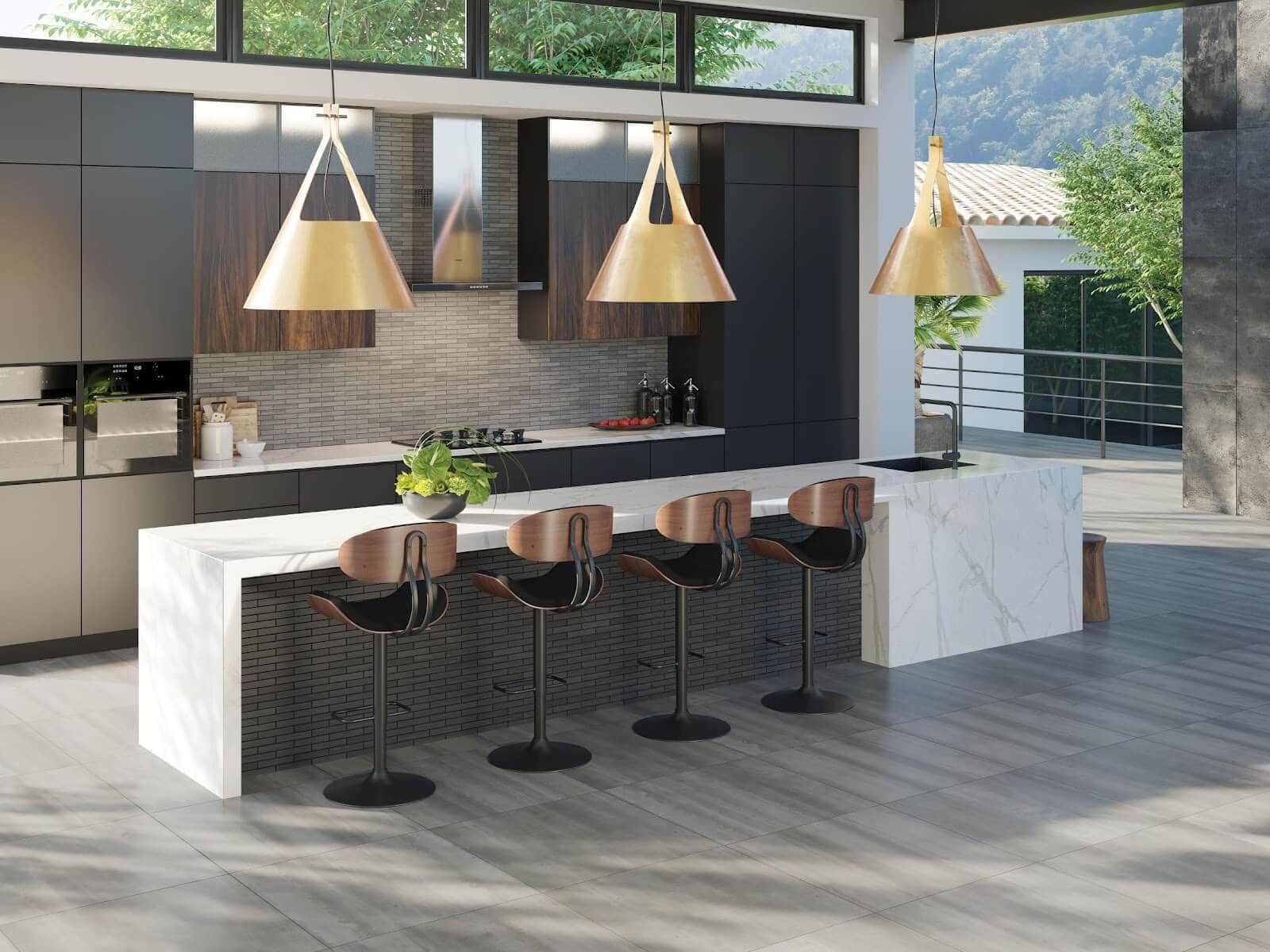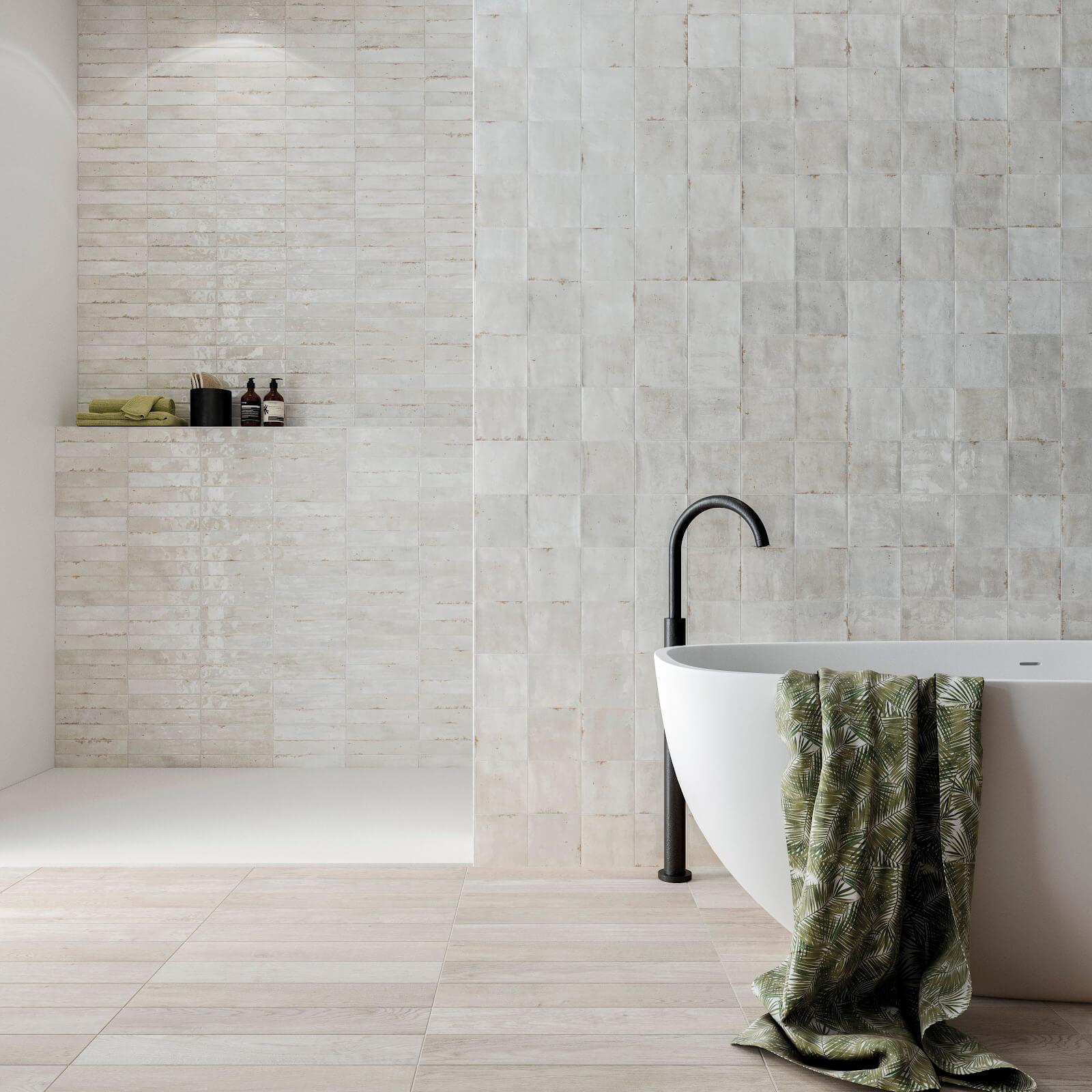Biophilic tile is one of the top tile trends set to make a design impression for 2021 and beyond.
Whether you’re already fully on board with this trend or are still catching up, we’re here to update you on everything you need to know about biophilic design and how to incorporate it into your home with ceramic tile.
What Is Biophilic Design?
You may have heard this term used before in discussions about paint color, furniture options, and interior design styles. Let’s pause to define what biophilic design means.
Biophilia is humans’ inherent tendency to seek out connections with nature and other life forms.
A combination of the Greek words for “life” (“bio”) and “love” (“philia”), biophilia can be translated literally as “love of life” — but in this case, life is interpreted as organic life, or nature, rather than the act of living.
Biophilic design, then, is an effort to fulfill this desire to connect with nature by incorporating natural elements into the built environment, and interior design specifically.
Some proponents of biophilic design even maintain that it is less of a want and more of an innate need, directly tied to our mental and physical well-being. After all, humans have spent most of their history on earth living in and among nature, and those ties don’t just disappear.
As Stephen R. Kellert, a Professor Emeritus at Yale’s School of Forestry and Environmental Studies, puts it, “We became biologically encoded to associate with natural features and processes.”
[Related: Ceramic Tile for Universal Design & Minimalist Trends]
What Are the Benefits of Biophilic Design?

Beyond the fulfillment of our need to connect with nature (or perhaps because of it), biophilic design provides many additional tangible benefits.
Health Benefits of Biophilic Design
Terrapin Bright Green explains that connecting with nature has been proven to improve our cognitive, psychological, and physiological well-being:
- Cognitive benefits: The ability to learn and think both logically and creatively, as well as memory and mental agility, all comprise our cognitive functioning. Regular or strong contact with nature presents the chance for mental restoration, during which time we can give our cognitive functions a break and increase our capacity for future tasks that require focusing.
- Psychological benefits: Our mood, emotions, attention, alertness, concentration, and adaptability make up our psychological state. Interacting with natural environments has been associated with lower levels of fatigue, anxiety, confusion, tension, and anger than urban environments. Nature is considered to be emotionally restorative and stress-reducing.
- Physiological benefits: Physiological well-being is related to our general physical comfort and as well as that of our respiratory, musculoskeletal, aural, and circadian systems. Connecting with nature has been shown to improve our physical well-being, such as by lowering stress hormones in the bloodstream, lowering diastolic blood pressure, and even causing our muscles to relax.
[Related: Health Benefits of Ceramic Tile]
Space-Specific Benefits of Biophilic Design
Oliver Heath Design also enumerates all of the benefits that biophilic design can bring to specific types of spaces, identified through studies from the past three-plus decades:
- Residential spaces: Natural elements make homes more peaceful and restorative. Neighborhoods with access to nature have lower crime rates and higher property prices.
- Workplaces: When incorporated into offices and other workplaces, biophilic design can reduce absenteeism and presenteeism and increase productivity, creativity, and well-being.
- Education: Biophilic design for education can increase attendance and concentration levels, reduce the impacts of ADHD, increase learning rates, and improve test results.
- Healthcare: An increased connection to nature has been shown to reduce use of pain medication as well as post-operative recovery times in healthcare settings.
- Hospitality: In the hospitality industry, guests are willing to pay more for rooms with views of nature or natural elements.
- Retail: Retail spaces with landscaping and vegetation tend to have higher rent prices, and customers are willing to spend more on products and services because of these features.
How to Incorporate Biophilic Design Into Your Home or Business

So, now that you understand the importance and many benefits of biophilic design, how can you add biophilic design to your space?
According to the experts, there are three primary categories of biophilic design: direct experiences of nature in your space, analogue representations of nature, and spatial elements of nature.
Each of these categories presents numerous options for biophilic design, meaning that there’s something for everyone and every space. Let’s take a closer look at examples of biophilic design in each category:
- Direct experiences of nature in your space: Just as it sounds, this involves bringing elements of nature into your space, such as:
- Plants
- Animals
- Water
- Natural light
- Shadows
- Natural scents
- Air
- Analogue representations of nature: If you can’t bring natural elements into your space, the next best thing is to incorporate representations of nature. This might include:
- Images of nature
- Natural materials
- Natural textures
- Natural patterns
- Natural colors
- Natural shapes
- Spatial elements of nature: Finally, you can create biophilic design in your space by replicating spatial elements found in nature, such as:
- Sweeping views, such as large windows overlooking a natural landscape
- Spaces that stimulate sensory refuge, such as a dark, quiet room reminiscent of a cave
- A minor sense of risk, such as a pond with stepping stones
With all of these ideas in hand, you can incorporate as little or as much biophilic design into your space as you want.
Benefits of Ceramic Tile for Biophilic Design

Some materials lend themselves to biophilic design more than others, and that’s certainly the case with ceramic tile. Biophilic advantages of ceramic tile:
- All-natural: Naturally-occurring ingredients make up ceramic tile, ensuring that the materials in your home are healthy, sustainable, and one with nature.
- Promotes healthy air quality: Ceramic tile contains no allergens and emits no volatile organic compounds (VOCs), chemicals that can cause health concerns when released into the air.
- Resists damage from water and scratches: Bring on the potted plants — ceramic tile won’t be damaged from splashes or drips from watering or scratches from dragging them around to maximize their sun exposure.
- Will not fade: Biophilic design calls for lots of windows and natural light. With some materials, you’d have to worry about fading due to sun exposure, but the color is baked right into ceramic tile and will not fade.
- Can be used both indoors and outdoors: A great option to bring nature into your space is to set up livable space outdoors or even open up your space to nature, creating indoor-outdoor spaces that blur the lines between inside and outside. Ceramic tile is a great choice for either of these options because its weather resistance enables ceramic tile to be used just about anywhere. You can even use the same tile both inside and outside your home, as in the picture above.
- Comes in limitless natural styles: Perhaps the easiest way of creating biophilic design is to choose natural colors and textures. Ceramic tile comes in an array of colors, styles, patterns, shapes, and textures you can find in nature (and many you can’t).
Let’s explore some of the many natural styles that are possible with ceramic tile.
[Related: Indoor-Outdoor Tile: Your Complete Guide]
Biophilic Tile Ideas
Biophilic tile encompasses any tile that emulates, depicts, or reminds you of nature — whether the connection is as subtle as a color or as direct as a natural pattern.
Tile in Natural Colors

Let’s start simple: Incorporate biophilic design into your home with ceramic tile in natural colors, such as earth tones. Think greens, browns, reds, and everything in between.
For example, this restaurant does a lovely job of combining the oxidized green floor tile with a weathered red brick wall, and the hanging ivy looks right at home.
[Related: Back to Nature: Ceramic Tile in Earth Tones]
Variegated Tile

Variegation is another trending biophilic tile option. Variegated tile features subtle color shading that produces a natural, organic appearance and is typical of handmade tile, stone-look tile, and gemstone-look tile.
This vertical tile grid features variegation as well as an earth tone, making it a biophilic design knockout. Oh, and did we mention that green tile is another expected 2021 tile trend?
[Related: We’re Green With Envy Over These Green Tile Designs]
Stone-Look Tile

Stone-look tile combines classic style with a natural aesthetic, proving that biophilic design can be as refined as any other trend. Options include marble looks, granite looks, slate looks, gemstone looks, and more.
In this dining area, hanging plants add a pop of color to the marble-look checkerboard tile’s gray and white color scheme.
[Related: Tile Trend Ideas: Giant Gemstones]
Wood-Look Tile

Wood looks are a biophilic design must-have. One benefit that wood-look ceramic tile provides over natural wood is that ceramic tile is resistant to fading, scratching, and water — all potential issues when you expose building materials to the natural elements!
[Related: Tile Trend Ideas: Refined Natural Wood Looks]
Tile in Natural Patterns

An alternative to tile in a natural look is tile with nature printed onto it — we’re talking about natural patterns such as stars, flowing lines that resemble hills or waves, florals and leaves, other botanicals, and more. With modern printing capabilities, any scene or design from nature you can imagine can be printed directly onto tile.
[Related: Tile Trend Ideas: Florals and Leaves]
Tile in Natural Textures

Nature isn’t all smooth and level surfaces — it has some texture, and tile can, too. Textured tile has a rustic look that fits right in with biophilic design.
To take this option even further, opt for three-dimensional tile with surfaces that resemble pebbles in a stream, ripples in sand, sloping hills, craggy cliffs, or your favorite natural landscape.
[Related: Tile Trend Ideas: Textured Tile]
Tile in Natural Shapes

Look for tile in natural shapes, such as flowers, leaves, stars, honeycomb-like hexagons, or seashells. Luckily, tile comes in many different shapes to inspire your biophilic creativity.
[Related: Tile Trend Ideas: Think Outside the Box]
Tap Into Your Inner Biophilia

These biophilic ceramic tile ideas have us itching to get outside and connect with nature — and to incorporate biophilic design into our own homes!
However you satisfy your own need to be one with the natural world, keep an eye out for the natural beauty surrounding you — both outdoors and, as biophilic design continues to become more popular, in the homes, businesses, and other spaces you visit.
Find biophilic tile for your own space or continue to explore biophilic tile ideas with our Biophilic Design Pinterest board.




